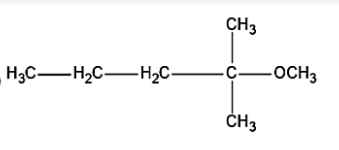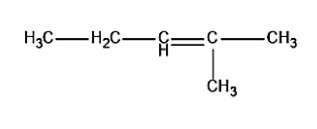
2-Chloro-2-methylbutane on reaction with sodium methoxide in methanol yields
a.
b. 
c. 
(A) All of these
(B) (a) and (c)
(C) (c)only
(D) (a) and (b)
Answer
140.4k+ views
Hint: When 2-Chloro-2-methylbutane reacts with sodium methoxide in methanol, it undergoes \[{S_N}1\] and \[{E_1}\]. \[{S_N}1\]means unimolecular nucleophilic substitution reaction and \[{E_1}\]means unimolecular elimination reaction. On knowing what type of reaction can take place in this \[{S_N}1\]and \[{E_1}\]mechanism we can determine the product.
Complete step by step answer:
2-Chloro-2-methylbutane when reacted with sodium methoxide in methanol, it will form a carbocation by the removal of \[NaCl\]. The formed carbocation will undergo \[{S_N}1\] and \[{E_1}\].
In \[{S_N}1\]mechanism, nucleophile will come and attack the same position of the leaving group, that means that the nucleophile, methoxy group \[C{H_3}{O^ - }\] will be attached in the position of the leaving chlorine \[C{l^ - }\] group. Thus, leading to the formation of 2-Methoxy-2-methylbutane i.e. compound (a) in the figure.
In the\[{E_1}\] mechanism, the deprotonation will occur in the carbon atom which is nearer to the carbocation and hence leading to the formation of alkene. In 2-methylbutane carbocation, there are two carbon atoms which are nearer to the carbocation. One carbon atom is at the terminal position and the other carbon atom is at the third position.
In the terminal carbon atom, a proton is removed, thus leading to the formation of 2-methyl-1-butene i.e. compound (b) in the figure.
In the third carbon atom, a proton will be removed, thus leading to the formation of 2-methyl-2-butene i.e. compound (c) in the figure.
Therefore, all the three compounds(a), (b) and (c) during the reaction of 2-Chloro-2-methylbutane with sodium methoxide in methanol.
Hence, the correct answer is option (A) all the above.
Additional information:
Comparison of \[{S_N}1\] and \[{S_N}2\]
Note: In the reaction both elimination and substitution reaction take place. In the elimination reaction the deprotonation of the carbocation takes places to form alkene, while in the substitution reaction, substitution of leaving group by a nucleophile takes place. Here substitution takes place at only one position while elimination is taking place at two positions.
Complete step by step answer:
2-Chloro-2-methylbutane when reacted with sodium methoxide in methanol, it will form a carbocation by the removal of \[NaCl\]. The formed carbocation will undergo \[{S_N}1\] and \[{E_1}\].
In \[{S_N}1\]mechanism, nucleophile will come and attack the same position of the leaving group, that means that the nucleophile, methoxy group \[C{H_3}{O^ - }\] will be attached in the position of the leaving chlorine \[C{l^ - }\] group. Thus, leading to the formation of 2-Methoxy-2-methylbutane i.e. compound (a) in the figure.
In the\[{E_1}\] mechanism, the deprotonation will occur in the carbon atom which is nearer to the carbocation and hence leading to the formation of alkene. In 2-methylbutane carbocation, there are two carbon atoms which are nearer to the carbocation. One carbon atom is at the terminal position and the other carbon atom is at the third position.
In the terminal carbon atom, a proton is removed, thus leading to the formation of 2-methyl-1-butene i.e. compound (b) in the figure.
In the third carbon atom, a proton will be removed, thus leading to the formation of 2-methyl-2-butene i.e. compound (c) in the figure.
Therefore, all the three compounds(a), (b) and (c) during the reaction of 2-Chloro-2-methylbutane with sodium methoxide in methanol.
Hence, the correct answer is option (A) all the above.
Additional information:
Comparison of \[{S_N}1\] and \[{S_N}2\]
| \[{S_N}1\] | \[{S_N}2\] |
| Unimolecular | Bimolecular |
| Rate depends on two species | Rate depends only on one species |
| Second order | First order |
| Solvent used is polar protic | Solvent used is Polar aprotic |
| Alkyl halide reacts in the order\[3^\circ > 2^\circ > 1^\circ \] | Alkyl halide reacts in the order\[1^\circ > 2^\circ > 3^\circ \] |
Note: In the reaction both elimination and substitution reaction take place. In the elimination reaction the deprotonation of the carbocation takes places to form alkene, while in the substitution reaction, substitution of leaving group by a nucleophile takes place. Here substitution takes place at only one position while elimination is taking place at two positions.
Recently Updated Pages
Classification of Drugs Based on Pharmacological Effect, Drug Action

Types of Solutions - Solution in Chemistry

Difference Between Alcohol and Phenol

JEE Main Participating Colleges 2024 - A Complete List of Top Colleges

JEE Main Maths Paper Pattern 2025 – Marking, Sections & Tips

Sign up for JEE Main 2025 Live Classes - Vedantu

Trending doubts
JEE Main 2025 Session 2: Application Form (Out), Exam Dates (Released), Eligibility, & More

JEE Main 2025: Derivation of Equation of Trajectory in Physics

JEE Main Exam Marking Scheme: Detailed Breakdown of Marks and Negative Marking

Learn About Angle Of Deviation In Prism: JEE Main Physics 2025

Electric Field Due to Uniformly Charged Ring for JEE Main 2025 - Formula and Derivation

JEE Main 2025: Conversion of Galvanometer Into Ammeter And Voltmeter in Physics

Other Pages
NCERT Solutions for Class 12 Chemistry Chapter 6 Haloalkanes and Haloarenes

NCERT Solutions for Class 12 Chemistry Chapter 2 Electrochemistry

NCERT Solutions for Class 12 Chemistry Chapter 7 Alcohol Phenol and Ether

NCERT Solutions for Class 12 Chemistry Chapter 1 Solutions

Solutions Class 12 Notes: CBSE Chemistry Chapter 1

Electrochemistry Class 12 Notes: CBSE Chemistry Chapter 2




